
Macabeo, also called Viura or Macabeu, is a white variety of wine grape.

Touriga Nacional is a variety of red wine grape, considered by many to be Portugal's finest. Despite the low yields from its small grapes, it plays a big part in the blends used for ports, and is increasingly being used for table wine in the Douro and Dão. Touriga Nacional provides structure and body to wine, with high tannins and concentrated flavors of black fruit. Jancis Robinson has compared its relationship with Touriga Francesa to the partnership between Cabernet Sauvignon and Cabernet Franc, the former providing structure, the latter filling out the bouquet.
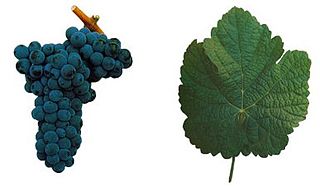
Touriga Francesa is one of the major grape varieties used to produce port wine. Touriga Francesa is lighter and more perfumed than Touriga Nacional, adding finesse to the wine. Touriga Francesa has been described by Jancis Robinson as playing "Cabernet Franc to Touriga Nacional’s Cabernet Sauvignon". It is a cross of two other indigenous Portuguese wine grape varieties Mourisco tinto and Touriga Nacional. Touriga Francesa is quite similar to Touriga Nacional, needing harsh conditions to keep vigor down as it gets on the steep arid slopes of the Douro. It is usually trained low to the ground under one of the Royat systems. Yields are medium (1,5 kg/vine), not as bad as Touriga Nacional.
Blauburger is a red wine grape variety that is grown a little in Austria, Czech Republic and Hungary. It should not be confused with Blauburgunder, which is an Austrian synonym for Pinot noir.
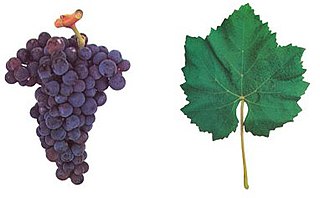
Castelão, in Portugal also known as Periquita and João de Santarém, is a red wine grape found primarily in the south coastal regions but is grown all over Portugal and is sometimes used in Port wine production. The name is derived from the Portuguese term for parakeet.
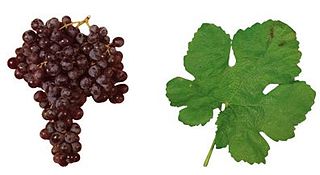
Tinta Negra Mole is a red Portuguese wine grape commonly used in the production of Madeira. It is the most widely planted variety on the Madeira islands and is considered the industry's "workhorse grape".

Cayetana blanca, also known as Cayetana or Jaén, is a white Spanish wine grape. It is grown mainly in the south of Spain, especially in Extremadura and in the Jerez region where it is distilled for use in brandy production.
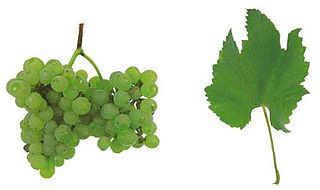
Fernão Pires is a white Portuguese wine grape grown throughout Portugal, especially in the Tejo and Bairrada, where it is also known as "Maria Gomes". This variety is known to produce wines with a spicy aromatic character, though often with delicate exotic fruity notes. Generally not expected to be a long-living wine, this wine is best drunk in its infancy or matured for up to 2 or 3 years. Outside of Portugal there are some significant plantings in South Africa.

Baga is a red Portuguese wine grape variety planted primarily in the Bairrada DOC. As a varietal, Baga produces tannic wines with high acidity.

Frappato di Vittoria or Frappato is a red Italian wine grape variety planted primarily in Sicily. As a varietal, Frappato produces light bodied wines with a distinct grapey aroma. It is most commonly seen as a component of Sicily's only DOCG wine, Cerasuolo di Vittoria, which consists of 30-50% Frappato and 50-70% Nero d'Avola.
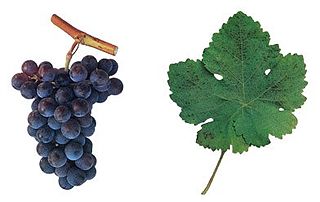
Ramisco is a red Portuguese wine grape variety that is planted primarily in the Colares DOC. As a varietal, Ramisco produces very tannic and astringent wines.
Azal Tinto or Amaral is a variety of red Portuguese wine grape. It is planted in the Minho region where it is used in red Vinho Verde, while the related Azal Branco is used for white Vinho Verde.
Carricante is a white wine indigenous to Sicily, Italy. This late-ripening vine is the main variety used in the Etna DOC. It is usually found blended with Catarratto and Minella bianca. As a varietal wine, Carricante produces a fresh, straw-yellow, lightly fragrant white wine. The name Carricante comes from the Italian caricare, in reference to the variety's heavy yields. It is not related to the variety Nocera, which is sometimes called Carricante nero. Carricante is grown at high altitudes on Mount Etna relative to other grapes, growing at around 950 meters above sea level on the eastern slopes and at 1,050 meters on the southern slopes. Wines made from it tend to be high in total acidity with a low pH and have traditionally been subject to malolactic fermentation.
Nocera is a dark black Italian grape variety producing deeply colored, high acidity wines. It originates from the north eastern region of Sicily and is now also grown in Calabria. It is an allowed component of five DOC wines as well as 15 IGT wines. It has good vigor but poor disease resistance.
Beba is a white Spanish grape variety grown for both wine and table grapes in the province of Extremadura. It is a vigorous, high-yielding vine that is sensitive to low temperatures and dampness during bloom. Annual productivity varies greatly depending on prevailing weather influences. It is grown for both wine and table grapes. It is also known as: Beba de los Santos, Beba de los Santos de Maimona, Beba de Palos, Beba Dorada, Beba Dorada de Huelva, Beba Dorada de Jaen, Beba Dorada de Jerez, Beva, Bevah, Bevan, Eva de los Santos, Eva de los Santos de Maimona, and White Malaga. This was the vine presented by Louis XIV's ambassador to King Narai of Siam, where it became the start of a flourishing grape industry.

Hebén is a very rare white grape variety grown for wine and table grapes in Spain. It is an ancient variety found to have originated as a table grape in North Africa as Gibi. It is the parent variety of a large number of grapes grown in the Iberian Peninsula and the wider Mediterranean. It has paired with Alfrocheiro to produce the rare Portuguese varieties Trincadeira das pratas, Tinta grossa, Castelão branco, and Malvasia fina, as well as the Spanish Allarén. With Muscat of Alexandria it has produced Moscatel nunes/Nuno gomes in Portugal and Moscatel de Angüés in Spain. In Spain, it has a parent relationship with some very widely grown varieties: Airén, Cayetana, Viura, Xarel·lo, and Pedro Ximénez. In total, around 60 offspring varieties have been identified. Its sparse bunches are an attribute that can be seen some in children varieties such as Pedro Ximénez and Xarello. It produces solely female flowers, unlike the majority of self-pollinating vinifera varieties grown for wine today.
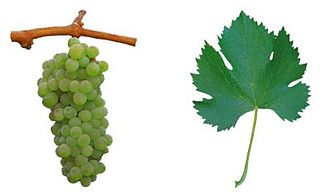
Antão Vaz is a native Portuguese white wine grape variety. Genetic testing has shown it to be a cross of the white Cayetana blanca and the almost unknown red João Domingos, which is thought to be extinct in its native Portugal. It is grown primarily in the Alentejo region, with additional plantings around Lisbon and in the Península de Setúbal. It is vigorous and productive, and requires a hot climate. The thick skins on these large loosely packed grapes enable them to withstand high heat and dehydration. It produces complex, light yellow wines with citrus and tropical aromas. Depending on the time of harvest, the wines can range from very acidic to ripe and alcoholic.
Prunesta is a rare native Italian red wine grape variety. According to Ian D'Agata in Native Wine Grapes of Italy: "It has a midium-sized, very stocky, pyramidal, winged bunch, with large, oval, blue-black berries." It is a component of 10 Calabrian IGT wines, primarily in the Province of Reggio Calabria and the Province of Crotone.
Garró is a native Spanish red wine grape variety close to extinction. The word garró means ankle, particularly that of a pig, in Catalan. It has historically been grown in Baix Ebre in Catalonia, as well as in Valencia, and other parts of eastern Spain. The Spanish DOPs of Pla de Bages in Catalonia and Valencia grow it as an authorised variety under the synonym Mandó.
Brustiano faux is an indigenous French wine grape that is no longer in cultivation in France as of 2010. The variety is currently preserved by the Centre de Ressources Biologiques de la Vigne, a division of the INRA in France.












